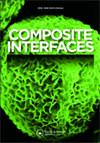通过特定的化学改性和挤出过程中的混合顺序,控制高岭土纳米管在LLDPE/EVA(70/30)共混物中的定位
IF 2.4
4区 材料科学
Q3 MATERIALS SCIENCE, COMPOSITES
引用次数: 0
摘要
摘要通过填料的功能化、增容剂的加入和工艺流程的调整,研究了高岭土纳米管(HNT)在线性低密度聚乙烯/乙烯-醋酸乙烯共聚物(LLDPE/EVA, 70/30)共混体系中的局部化控制。首先,用3-氨基丙基三乙氧基硅烷(APTES)、十二烷基三氯硅烷(DTCS)和三acontyltrichlosi烷(C30)三种不同的有机硅烷对HNT进行表面改性。无论有机硅烷的性质如何,接枝量均达到0.10 mmol/g左右。然后,使用微挤出机将未改性和改性的HNT与LLDPE/EVA(70/30)聚合物共混物混合,并通过扫描电子显微镜(SEM)分析检查填料的定位。结果表明,纯HNT和改性HNT均集中于EVA相。根据接触角测定的纯HNT和改性HNT的润湿性系数,对这些观察结果进行了讨论。将PE-g-MA作为相容剂添加到含有HNT- aptes的共混物中,可以使HNT定位在LLDPE相中。最后,利用双螺杆挤出机对不同组分混合顺序的影响进行了评估,并成功地将改性的HNT定位到LLDPE相。作者要感谢里昂第一大学微结构中心的Pierre Alcouffe和成员在电子显微镜表征方面的帮助。披露声明作者未报告潜在的利益冲突。作者要感谢法国国家研究局(ANR-18-CE06-0020-03)的资助和竞争力集群Polymeris和Axelera。本文章由计算机程序翻译,如有差异,请以英文原文为准。
Control of halloysite nanotubes localization into a LLDPE/EVA (70/30) blend through specific chemical modifications and sequence of mixing during extrusion
ABSTRACTThe control of the localization of halloysite nanotubes (HNT) in a linear low-density polyethylene/ethylene-vinyl acetate copolymer (LLDPE/EVA, 70/30) blend was studied through three approaches: i) Functionalization of the filler, ii) Addition of a compatibilizer and iii) Modification of the processing sequence. First, the HNT surface modification was carried out with three different organosilanes (3-aminopropyltriethoxysilane (APTES), dodecyltricholosilane (DTCS) and triacontyltrichlorosilane (C30)). Grafting amounts about 0.10 mmol/g were reached whatever the nature of the organosilane. Then, the unmodified and modified HNT were mixed with a LLDPE/EVA (70/30) polymer blend using a microextruder and the localization of the fillers were scrutinized by scanning electron microscopy (SEM) analysis. It was observed that both the neat HNT and modified HNT were mostly localized in the EVA phase. These observations were also discussed according to the wettability coefficient determined for neat HNT and modified HNT thanks to contact angle measurements. The addition of PE-g-MA as a compatibilizer to the blend containing the HNT-APTES allowed to localize the HNT in the LLDPE phase. Finally, the influence of the mixing sequence of the different components was evaluated by using a twin-screw extruder, and it was successfully used to localize the modified HNT into the LLDPE phase.KEYWORDS: Halloysite nanotubesfunctionalizationextrusionPE/EVA blend AcknowledgementsThe authors would like to thank Pierre Alcouffe and the members of the Center of Microstructures of the University of Lyon 1 for their assistance in electron microscopy characterizations.Disclosure statementNo potential conflict of interest was reported by the author(s).Additional informationFundingThe authors would like to thank the French National Agency for Research (ANR-18-CE06-0020-03) for funding and the competitiveness clusters Polymeris and Axelera.
求助全文
通过发布文献求助,成功后即可免费获取论文全文。
去求助
来源期刊

Composite Interfaces
工程技术-材料科学:复合
CiteScore
5.00
自引率
3.80%
发文量
58
审稿时长
3 months
期刊介绍:
Composite Interfaces publishes interdisciplinary scientific and engineering research articles on composite interfaces/interphases and their related phenomena. Presenting new concepts for the fundamental understanding of composite interface study, the journal balances interest in chemistry, physical properties, mechanical properties, molecular structures, characterization techniques and theories.
Composite Interfaces covers a wide range of topics including - but not restricted to:
-surface treatment of reinforcing fibers and fillers-
effect of interface structure on mechanical properties, physical properties, curing and rheology-
coupling agents-
synthesis of matrices designed to promote adhesion-
molecular and atomic characterization of interfaces-
interfacial morphology-
dynamic mechanical study of interphases-
interfacial compatibilization-
adsorption-
tribology-
composites with organic, inorganic and metallic materials-
composites applied to aerospace, automotive, appliances, electronics, construction, marine, optical and biomedical fields
 求助内容:
求助内容: 应助结果提醒方式:
应助结果提醒方式:


